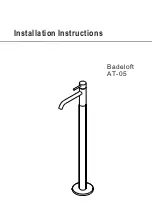
English (GB)
5
1.6.1 Diaphragm leakage detection (optional)
Applies to DDA-AR control variant.
Pumps with diaphragm leakage detection (DLD)
have a special dosing head with a special diaphragm
and a pressure switch. The pressure switch is fitted
and connected to the pump on delivery.
For pumps with diaphragm leakage detection the
pressure differential between inlet and outlet side
must be at least 2 bar / 29 psi.
Fig. 1
Diaphragm leakage detection
In case of a leak in the working diaphragm:
•
Dosing medium (4) penetrates between working
diaphragm (D1) and protective diaphragm (D3)
and is transferred to the pressure switch (1)
through the signal diaphragm (D2).
•
On the next discharge stroke the increasing
pressure activates the pressure switch (1).
•
The pump indicates an alarm and stops.
The pump provides two relay outputs, which can be
used to trigger an external alarm, for example.
Replace the diaphragm as soon as possible after a
diaphragm leakage was detected.
If both the working diaphragm (D1) and the
protective diaphragm (D3) are damaged, dosing
liquid escapes from the drain opening (3) on the
dosing head.
2. Storage and handling
2.1 Storage
•
Observe the permissible ambient conditions. See
section
4. Technical data / Dimensions
•
The storage location must be protected from rain,
humidity, condensation, direct sunlight and dust.
•
The product must be drained completely.
•
The product must be cleaned.
2.2 Unpacking
•
Mount as soon as possible after unpacking.
•
Observe the permissible ambient conditions. See
section
4. Technical data / Dimensions
2.3 Transport
•
The product must only be transported by trained
persons.
•
Wear personal protective equipment.
•
Observe the permissible ambient conditions. See
section
4. Technical data / Dimensions
•
The product must be drained completely.
•
The product must be cleaned.
•
Use the original packaging or equivalent to
protect the product during transport.
•
Use appropriate lifting and transporting devices.
•
Secure the product during transport to prevent it
from tilting and moving.
•
Avoid strong impact loads.
•
If the pump is installed in a system during
transport, make sure it is secured on the
mounting plate with the 6 vertical safety screws.
See section
5.1.3 Installing the pump on the
.
T
M
06
72
58
37
16
Pos.
Components
1
Pressure switch
2
Dosing head
3
Drain opening
4
Dosing medium
D1
Working diaphragm
D2
Signal diaphragm (intermediate layer)
D3
Protective diaphragm
Replace the pressure switch, if the
diaphragm of the pressure switch is
damaged.
Immediately separate the pump from the
power supply. Observe section
.
D1
D2
D3
1
3
4
2






































